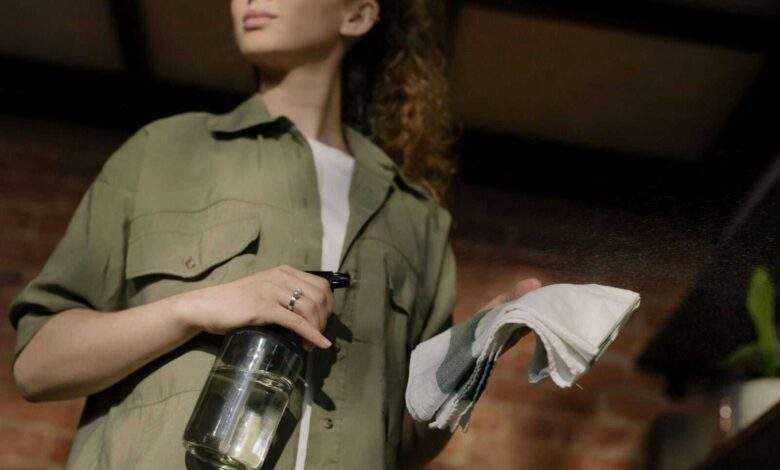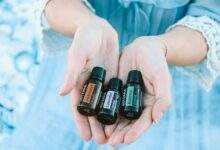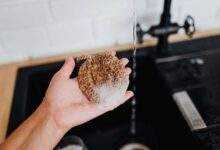Natural Cleaning Powerhouse: DIY Multipurpose Cleaner with Essential Oils

Table of Contents
Unveiling the Toxin Trap: Why Go Natural?
A. The Pitfalls of Conventional Cleaners
Conventional cleaning products often contain harsh chemicals that can pose significant health risks and environmental concerns. Ingredients like ammonia, chlorine bleach, and phthalates are common in many household cleaners, yet they can cause respiratory issues, skin irritation, and other health problems. For children and pets, who are more vulnerable to toxins due to their smaller size and developing systems, exposure can be particularly dangerous.
Beyond personal health, conventional cleaners contribute to environmental degradation. When washed down the drain, these chemicals enter water systems, leading to pollution that harms aquatic life and disrupts ecosystems. Wastewater treatment plants are not always equipped to filter out all these substances, resulting in their eventual entry into rivers, lakes, and oceans.
The environmental impact extends to air quality as well. Volatile organic compounds (VOCs) in cleaning products can evaporate into the air, contributing to indoor air pollution and smog formation. Considering these factors, it’s clear that the shift towards natural cleaning solutions is not just a personal health choice but an environmental necessity.
B. The Allure of Natural Cleaning
Natural cleaning solutions offer numerous benefits, making them an attractive alternative to conventional cleaners. Ingredients such as vinegar, castile soap, and essential oils are effective in tackling household cleaning tasks without the associated health risks of synthetic chemicals.
Vinegar, for instance, is a natural disinfectant that can cut through grease and grime, while castile soap, a plant-based soap, is gentle yet effective at cleaning various surfaces. Essential oils add both fragrance and antimicrobial properties, enhancing the cleaning power and sensory experience of DIY cleaners.
Economically, DIY cleaning solutions are often more affordable than store-bought alternatives. By purchasing basic ingredients in bulk, you can create large quantities of cleaner at a fraction of the cost. This not only saves money but also reduces the packaging waste associated with commercial cleaning products, promoting a more sustainable lifestyle.
C. Embracing a DIY Ethos
Creating your own cleaning solutions is empowering and satisfying. It allows you to control the ingredients, ensuring that they are safe and effective. Additionally, you can customize your cleaners with specific essential oils to suit your fragrance preferences and cleaning needs, making the cleaning process more enjoyable.
The DIY approach also aligns with eco-friendly practices. By using reusable spray bottles and reducing reliance on single-use plastics, you contribute to waste reduction and sustainability. The sense of accomplishment and positive environmental impact from making and using your own cleaners can inspire further green living initiatives in other areas of your life.
The DIY Powerhouse: Your Essential Cleaning Arsenal
A. The All-Star Ingredient: Vinegar’s Cleaning Prowess
Vinegar is a versatile and powerful cleaning agent, renowned for its natural disinfectant properties. Its acetic acid content makes it effective against a wide range of bacteria and viruses, ensuring a hygienic clean without the need for harsh chemicals.
Science Behind Vinegar’s Effectiveness:
The acetic acid in vinegar breaks down grease, grime, and mineral deposits. Its low pH helps dissolve dirt and bacteria, making it a potent cleaning agent for various household tasks.
Choosing the Right Vinegar:
- White Vinegar: Ideal for most cleaning tasks due to its strong acidity and lack of coloring, which prevents staining.
- Apple Cider Vinegar: Suitable for gentle surfaces and adds a pleasant scent, though it may leave a slight residue compared to white vinegar.
Usage Tips:
- Mix vinegar with water for an all-purpose cleaner.
- Use undiluted vinegar for tough stains and disinfecting surfaces.
- Combine vinegar with baking soda for a foaming, abrasive cleaner.
B. The Gentle Giant: Castile Soap’s Cleaning Power
Castile soap, made from olive oil and other plant-based oils, is a gentle yet effective cleaning agent. Its mildness makes it suitable for sensitive skin, and its natural composition ensures it is safe for the environment.
Benefits:
- Skin-Friendly: Ideal for DIYers with sensitivities or allergies.
- Effective Cleaner: Cuts through grease and grime effortlessly.
- Versatile: Can be used for various cleaning tasks, from dishes to floors.
Selection and Dilution:
- Liquid Castile Soap: Convenient for quick mixing and application.
- Bar Castile Soap: Can be grated and dissolved in water for a liquid solution.
- Dilution Ratios: Vary based on the cleaning task. A common mixture is 1/4 cup of castile soap per quart of water.
C. Nature’s Fragrant Warriors: Essential Oils for Enhanced Cleaning
Essential oils not only add a pleasant fragrance to your cleaning solutions but also offer natural antibacterial, antiviral, and antifungal properties.
Popular Essential Oils:
- Tea Tree Oil: Known for its strong antibacterial and antiviral properties.
- Lemon Essential Oil: Effective at cutting through grease and provides a fresh scent.
- Lavender Essential Oil: Offers antibacterial properties and a calming fragrance.
Safety Guide:
- Always dilute essential oils before use to avoid skin irritation.
- Avoid direct contact with skin and eyes.
- Store essential oils in a cool, dark place to maintain their potency.
D. The Secret Weapon: Baking Soda’s Cleaning Versatility
Baking soda is a natural deodorizer and mild abrasive, making it ideal for scrubbing surfaces and neutralizing odors.
Cleaning Applications:
- Scrubbing Paste: Mix baking soda with water to create a paste for scrubbing ovens, sinks, and countertops.
- Odor Absorber: Sprinkle baking soda on carpets, let it sit for a few hours, and then vacuum to remove odors.
- Deodorizing Spray: Dissolve baking soda in water and use it as a spray to neutralize odors on fabrics and upholstery.
E. The Green Supporting Cast: Additional Natural Cleaning Options
Beyond the core ingredients, several other natural substances can enhance your DIY cleaning solutions.
Lemon Juice: A natural bleach and disinfectant, effective for cutting grease and removing stains.
Borax: A natural mineral that can boost the cleaning power of your solutions, though it should be used with caution due to potential skin irritation.
Hydrogen Peroxide: Useful for disinfecting and removing stubborn stains. Always store it in a dark container to maintain its efficacy.
Safety Precautions:
- Use borax and hydrogen peroxide sparingly and with appropriate protective gear.
- Ensure proper ventilation when using these substances to avoid inhaling fumes.
Crafting Your Concoction: DIY All-Purpose Cleaner Recipe
A. The Basic Recipe: A Powerful All-Purpose Cleaner
Creating your own all-purpose cleaner is straightforward and customizable. Here’s a basic recipe:
Ingredients:
- 1 cup of distilled water
- 1 cup of white vinegar
- 1 tablespoon of castile soap
- 10-15 drops of essential oil (e.g., tea tree oil for disinfecting, lemon essential oil for a fresh scent)
Instructions:
- Combine the water and vinegar in a reusable spray bottle.
- Add the castile soap and essential oil.
- Shake well to mix the ingredients thoroughly.
- Label the bottle clearly and store it in a cool, dark place.
Variations:
- For Bathrooms: Use tea tree oil for its antimicrobial properties.
- For Kitchens: Use lemon essential oil for its grease-cutting power.
B. Gearing Up for DIY Cleaning
Essential tools and equipment can make DIY cleaning easier and more effective.
Checklist:
- Reusable spray bottles
- Funnels for easy pouring
- Measuring cups and spoons
- Microfiber cloths for efficient cleaning
- Labels for clearly marking your solutions
Tips:
- Opt for glass spray bottles to avoid potential chemical reactions with plastic.
- Use colored labels to differentiate between various cleaning solutions.
C. Safety First: Essential Precautions for DIY Cleaning
When making and using DIY cleaners, safety is paramount.
Precautions:
- Ensure proper ventilation to avoid inhaling fumes.
- Wear gloves to protect your skin from potential irritation.
- Never mix different cleaning agents, such as vinegar and bleach, as this can create toxic fumes.
- Store DIY cleaning solutions out of reach of children and pets, preferably with childproof caps.
Conquering Every Corner: Targeted Cleaning Solutions with Essential Oils
A. Kitchen Champions
The kitchen is often the busiest and messiest area of the home, requiring powerful yet safe cleaning solutions.
DIY Recipes:
- Degreasing Stovetops: Create a paste with baking soda and water to scrub away grease. Add a few drops of lemon essential oil for extra grease-cutting power.
- Disinfecting Countertops: Mix vinegar, water, and lemon essential oil in a spray bottle. Spray and wipe with a microfiber cloth.
- Cleaning Appliances: Use a mixture of castile soap and water for a gentle yet effective clean. Add lavender essential oil for a pleasant scent.
B. Bathroom Blitz
Bathrooms require cleaners that can tackle grime, soap scum, and bacteria effectively.
DIY Recipes:
- Disinfecting Toilets: Sprinkle baking soda into the toilet bowl, add a cup of vinegar, and let it sit. Scrub with a toilet brush for a sparkling clean.
- Cleaning Shower Tiles: Make a paste with baking soda, water, and a few drops of tea tree oil. Scrub the tiles and rinse thoroughly.
- Removing Soap Scum: Mix castile soap and water in a spray bottle, apply to surfaces, and scrub with a sponge.
C. Living Room Luminaries
Maintaining a clean and fresh living room enhances comfort and relaxation.
**DIY
Recipes**:
- Dusting Furniture: Mix olive oil and lemon juice for a natural furniture polish. Apply with a soft cloth and buff to a shine.
- Cleaning Windows: Combine vinegar and water in a spray bottle, spray on windows, and wipe with a microfiber cloth for streak-free results.
- Refreshing Carpets: Sprinkle baking soda over carpets, let it sit for a few hours, and vacuum thoroughly to remove odors.
D. Laundry Powerhouse
Natural laundry solutions can be just as effective as conventional products.
DIY Recipes:
- Natural Laundry Detergent: Mix castile soap, baking soda, and washing soda. Use with caution and wear gloves to avoid skin irritation.
- Eco-Friendly Alternatives: Use wool dryer balls to reduce static and soften clothes. Add a few drops of essential oil for fragrance. Add vinegar to the rinse cycle to soften fabrics and reduce odors.
Living the Green Clean Dream: Tips and Beyond
A. Green Cleaning Hacks for a Sparkling Home
Practical tips and tricks can enhance the effectiveness of your DIY cleaning solutions.
Tips:
- Stubborn Stains: Use a paste of baking soda and water for scrubbing. For tough stains, let the paste sit before scrubbing.
- Deodorizing Fabrics: Mix equal parts water and vinegar in a spray bottle and lightly mist fabrics. Allow them to air dry.
- Streak-Free Surfaces: Use microfiber cloths, which are highly effective at picking up dirt and dust without streaking.
B. Going Green Beyond Cleaning
Expanding your natural cleaning efforts to other household products promotes overall sustainability.
DIY Recipes:
- natural air fresheners: Mix water, vinegar, and essential oils in a spray bottle for a natural air freshener.
- Furniture Polish: Combine olive oil and lemon juice for a homemade polish that nourishes wood.
- Stain Removers: Use a paste of baking soda and water for treating stains on fabric. Test on a small area first.
Eco-Friendly Alternatives:
- Switch to reusable cloths and towels instead of paper towels.
- Use washable cleaning pads instead of disposable ones.
C. The Green Cleaning Community
Engaging with the green cleaning community can provide inspiration, tips, and support.
Resources:
- Blogs: Follow blogs like Treehugger for insights on sustainable living and natural cleaning.
- Forums: Join forums like Reddit’s r/EcoFriendly for discussions and advice on green cleaning.
- Social Media Groups: Participate in Facebook groups dedicated to DIY cleaning and sustainable living.
A Greener Future, One Spray at a Time
A. The Power of Small Choices
Every small choice towards green cleaning contributes to a healthier environment. By adopting DIY cleaning solutions, you reduce exposure to harmful chemicals and decrease environmental pollution.
Benefits:
- Cost savings from making your own cleaners.
- Healthier home environment with fewer toxins.
- Reduced plastic waste from using reusable containers.
B. Advocacy for Change
Supporting eco-friendly companies and advocating for sustainable cleaning practices can amplify your impact.
Actions:
- Purchase from companies that prioritize natural ingredients and sustainable packaging.
- Advocate for policies that promote green cleaning and reduce reliance on harsh chemicals.
- Educate others about the benefits of natural cleaning solutions.
C. The Journey Continues
Transitioning to DIY cleaning may require adjustments, but the benefits are worth it.
Encouragement:
- Experiment with different recipes to find what works best for you.
- Celebrate small victories and improvements in your cleaning routine.
- Stay motivated by connecting with the green cleaning community.
Bonus Section: Essential Oil Spotlight
Popular Essential Oils:
- Lavender Oil: Known for its relaxing properties and mild antibacterial effects. Ideal for light cleaning tasks and freshening up fabrics.
- Peppermint Oil: Provides a refreshing scent and strong antimicrobial properties. Great for kitchens and bathrooms.
- Tea Tree Oil: Highly effective against bacteria and viruses. Perfect for disinfecting surfaces.
Applications:
- Add lavender oil to your laundry rinse cycle for a relaxing scent.
- Use peppermint oil in kitchen cleaners for a refreshing, clean aroma.
- Incorporate tea tree oil into bathroom cleaners for enhanced antimicrobial action.
Purchasing Tips:
- Buy from reputable sources to ensure high-quality, pure essential oils.
- Look for oils that are organic and sustainably sourced.
Green Cleaning FAQs: Unleash the Power of Nature in Your Home
This FAQ tackles common questions you might have as you embark on your natural cleaning adventure:
1. Is DIY cleaning with essential oils really effective?
Absolutely! Vinegar, castile soap, and essential oils offer powerful cleaning properties for various tasks. Research the best oils for specific cleaning needs (e.g., tea tree oil for bathrooms).
2. What vinegar should I use for cleaning?
White vinegar is your go-to for most cleaning tasks. Apple cider vinegar can be used on gentler surfaces due to its milder acidity.
3. Are essential oils safe for everyone?
Essential oils are potent and can irritate skin or eyes. Always dilute them properly and avoid direct contact. Keep them out of reach of children and pets.
4. What other natural cleaning ingredients can I use?
Baking soda is a fantastic deodorizer and mild abrasive. Lemon juice offers natural bleaching power. Borax can tackle tough stains (use with caution due to potential skin irritation).
5. How do I make my own all-purpose cleaner?
Combine vinegar, castile soap, and water in a spray bottle. Customize it with essential oils for fragrance and added cleaning power (check recipe section for details).
6. What are some good green cleaning practices for my kitchen?
Use a vinegar spray with lemon essential oil to disinfect countertops. Make a baking soda paste to tackle tough oven grease.
7. How can I clean my bathroom naturally?
A vinegar and baking soda combo disinfects toilets. Use a castile soap solution to clean shower tiles. Baking soda paste with essential oil removes soap scum.
8. Is there a green alternative to laundry detergent?
Yes! Try a DIY solution with castile soap, baking soda, and washing soda (use caution due to skin irritation). Consider eco-friendly laundry balls or adding vinegar to the rinse cycle.
9. Where can I find more natural cleaning recipes?
This blog offers several recipes! Explore online resources like blogs, forums, and social media groups dedicated to green cleaning.
10. Is switching to natural cleaning products expensive?
Not at all! DIY solutions are often cheaper than store-bought products. You’ll likely already have some ingredients on hand, and essential oils can last a long time.








